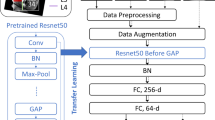Abstract
The 3D ultrasound features of patients with pelvic organ prolapses (POP) were analyzed using deep learning algorithms to explore the diagnostic efficacy of deep learning in identifying the types of POP and evaluate the feasibility of pelvic floor 3D ultrasound in diagnosing POP. Forty-four POP patients were included as the research objects, including 17 cases of anterior cavity prolapse, 23 cases of middle cavity prolapse, and four cases of posterior cavity prolapse. Twenty healthy women without POP were the control group. The 3D perineum ultrasound images of the patients were collected. A feature classification model for pelvic floor ultrasound images was built using deep learning algorithms. The proposed model was then compared with three convolutional neural network (CNN) models: support vector machine (SVM), radial basis function (RBF), and K-nearest neighbor (KNN), to evaluate its diagnostic efficiency in identifying the types of POP. Furthermore, the POP-Q score was performed based on ultrasound features. The results showed that the area under the curve (AUC) of the deep learning model was 0.79, and the 95% confidence interval was 0.76–0.80, higher than those of the CNN models. The accuracy (0.86), sensitivity (0.89), and specificity (0.84) of the deep learning model were higher than those of the three CNN models. The pelvic mouths of the study group and the control group were significantly more extensive than that of the nonproductive group (p < 0.05). The levator ani muscle of the POP group was significantly more extensive than that of the control group, and the difference was statistically significant (p < 0.05). The model based on deep learning has high efficiency in identifying the types of POP. The 3D ultrasound examination has important clinical significance for POP diagnosis.








Similar content being viewed by others
References
Iglesia CB, Smithling KR (2017) Pelvic organ prolapse. Am Fam Phys 96(3):179–185
Vergeldt TF, Weemhoff M, IntHout J, Kluivers KB (2015) Risk factors for pelvic organ prolapse and its recurrence: a systematic review. Int Urogynecol J 26(11):1559–1573
Liedl B, Goeschen K, Durner L (2017) Current treatment of pelvic organ prolapse correlated with chronic pelvic pain, bladder and bowel dysfunction. Curr Opin Urol 27(3):274–281
Dietz HP (2015) Pelvic organ prolapse—a review. Aust Fam Phys 44(7):446–452
Lai QY, Yang X, Zhu Y, Tan C, Ling M (2016) Prospective study of the Perigee system in the treatment of anterior pelvic organ prolapse. Zhonghua Fu Chan Ke Za Zhi 51(2):103–108
Madhu C, Swift S, Moloney-Geany S, Drake MJ (2018) How to use the pelvic organ prolapse quantification (POP-Q) system? Neurourol Urodyn 37(S6):S39–S43
Resende APM, Bernardes BT, Stupp L, Oliveira E, Castro RA, Girao M, Sartori MGF (2019) Pelvic floor muscle training is better than hypopressive exercises in pelvic organ prolapse treatment: an assessor-blinded randomized controlled trial. Neurourol Urodyn 38(1):171–179
Dietz HP (2019) Ultrasound in the assessment of pelvic organ prolapse. Best Pract Res Clin Obstet Gynaecol 54:5412–5430
Pehrson LM, Lauridsen C, Nielsen MB (2018) Machine learning and deep learning applied in ultrasound. Ultraschall Med 39(4):379–381
Sahiner B, Pezeshk A, Hadjiiski LM, Wang X, Drukker K, Cha KH, Summers RM, Giger ML (2019) Deep learning in medical imaging and radiation therapy. Med Phys 46(1):e1–e36
Song J, Chai YJ, Masuoka H, Park SW, Kim SJ, Choi JY, Kong HJ, Lee KE, Lee J, Kwak N, Yi KH, Miyauchi A (2019) Ultrasound image analysis using deep learning algorithm for the diagnosis of thyroid nodules. Medicine (Baltimore) 98(15):e15133
Huemer H (2019) Pelvic organ prolapse. Ther Umsch 73(9):553–558
Tso C, Lee W, Austin-Ketch T, Winkler H, Zitkus B (2018) Nonsurgical treatment options for women with pelvic organ prolapse. Nurs Womens Health 22(3):228–239
Weintraub AY, Glinter H, Marcus-Braun N (2020) Narrative review of the epidemiology, diagnosis and pathophysiology of pelvic organ prolapse. Int Braz J Urol 46(1):5–14
Zhang H, Zhu L, Xu T, Lang JH (2016) Utilize the simplified POP-Q system in the clinical practice of staging for pelvic organ prolapse: comparative analysis with standard POP-Q system. Zhonghua Fu Chan Ke Za Zhi 51(7):510–514
Shek KL, Dietz HP (2016) Assessment of pelvic organ prolapse: a review. Ultrasound Obstet Gynecol 48(6):681–692
Nemec M, Horcicka L, Dibonova M, Krcmar M, Urbankova I, Krofta L, Feyereisl J (2018) MRI analysis of the musculo-fascial component of pelvic floor in woman before planned vaginal reconstruction procedur for symptomatic pelvic organ prolapse. Ceska Gynekol 83(2):84–93
Kobi M, Flusberg M, Paroder V, Chernyak V (2018) Practical guide to dynamic pelvic floor MRI. J Magn Reson Imaging 47(5):1155–1170
Vellucci F, Regini C, Barbanti C, Luisi S (2018) Pelvic floor evaluation with transperineal ultrasound: a new approach. Minerva Ginecol 70(1):58–68
Funding
This research was supported by Minhang District Nature Science Fund of Shanghai of China 2016MHZ15.
Author information
Authors and Affiliations
Corresponding author
Ethics declarations
Conflict of interest
Author Li Duan declares that he has no conflict of interest. Author Yangyun Wang declares that he has no conflict of interest. Author Juxiang Li declares that he has no conflict of interest. Author Ningming Zhou declares that he has no conflict of interest.
Ethical approval
All procedures performed in studies involving human participants were in accordance with the ethical standards of the institutional and/or national research committee and with the 1964 Helsinki declaration and its later amendments or comparable ethical standards.
Human and animal rights
This article does not contain any studies with animals performed by any of the authors.
Informed consent
Informed consent was obtained from all individual participants included in the study.
Additional information
Publisher's Note
Springer Nature remains neutral with regard to jurisdictional claims in published maps and institutional affiliations.
Rights and permissions
About this article
Cite this article
Duan, L., Wang, Y., Li, J. et al. Exploring the clinical diagnostic value of pelvic floor ultrasound images for pelvic organ prolapses through deep learning. J Supercomput 77, 10699–10720 (2021). https://doi.org/10.1007/s11227-021-03682-y
Accepted:
Published:
Issue Date:
DOI: https://doi.org/10.1007/s11227-021-03682-y




